Overview
[ Top
| Version B
| Version C
| Return to H.E.C. Ascenders
]
Version A
(#2938, 2939)
Technical Details
I acquired one pair of Xinda ascenders on eBay from SaveMoneyForYou and a second pair from welltopshophk17, both in 2019.
This version is 192 mm. tall, 95 mm. wide, 28 mm. thick, and weighs 212 g.
The shell is a tall irregular shaped stamping made from 3.9 mm.
aluminum alloy sheet metal. A 14 mm. wide rope channel is formed in the upper
portion of one side and a smaller cam channel lies opposite the
first. A hole drilled through both sides of the cam channel accepts
a 5 mm. brazier rivet. The cam and cam spring are mounted
on this rivet. The rivet is centered 47 mm. from the inside of the rope channel. The head of the rivet is on the front, and the rear is expanded into a stainless steel bushing rather than directly into the aluminum shell. The shell has stamped reinforcing that supports the rope channel and a second stamped reinforcing rib that runs down the front strap.
The handle below the cam has a black "rubbery" plastic hand grip
molded into place. The hand grip has four finger grooves. The index finger support is larger than the others. A 27.4 mm.
long, 15.9 mm. tall D-shaped sling attachment hole is punched below the handle opening. This
hole is slightly beveled. An 18.6 by 16.5 mm. hole through both sides
of the rope channel provides an attachment point just above the
cam.
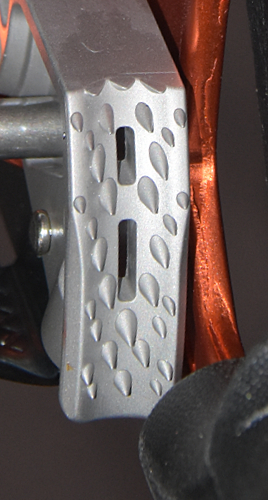 The cam is a reinforced stainless steel steel casting. The cam radius increases from 36 to 54 mm. over an angle of 36°, giving a 32° cam angle. The cam has
number of small conical teeth, all of which have their axes approximately
parallel to the upper surface of the cam. The cam face is divided by two short vertical slots designed to provide
clearance for mud. The tooth pattern is (3.4)((1S1)^2(4)(1S1)^4(5.4.3, where the "S"s stand for
a longitudinal mud removal slot. Like many other ascenders, the inner cam face radius
reduces from top to bottom to accommodate various sized ropes.
The cam is a reinforced stainless steel steel casting. The cam radius increases from 36 to 54 mm. over an angle of 36°, giving a 32° cam angle. The cam has
number of small conical teeth, all of which have their axes approximately
parallel to the upper surface of the cam. The cam face is divided by two short vertical slots designed to provide
clearance for mud. The tooth pattern is (3.4)((1S1)^2(4)(1S1)^4(5.4.3, where the "S"s stand for
a longitudinal mud removal slot. Like many other ascenders, the inner cam face radius
reduces from top to bottom to accommodate various sized ropes.
A stamped, spring-loaded manual safety tab is mounted on the bottom of
the cam with a steel rivet. The thumb surfaces of the tab are textured. The normal action
of the spring holds the safety against the cam. When the cam is
opened, the shell interferes with the safety tab, thus preventing
opening the cam. If the safety bar is moved away from the cam
(opposing the spring), it will clear the shell and the cam will
open. At full open the safety can be released and the spring will
hold the safety against the back of the shell. This provides a
means of locking the cam open. A 6 mm. stainless steel pin pressed into the side of the cam acts as a cam stop by striking the outer edge of the rope groove.
The front of the shell is printed with with a logo, "XINDΛ," a hollow arrow with "UP" inside, and a rigging illustration. The rear is printed with "CE," "EN 567:2013," "Max 150KG," "ROPE:Ø8-13mm," and "MADE IN CHINA."
These are well-made ascenders and
perform much like the Petzl Ascension.
All sharp edges have been removed. The attachment points are simple
yet well-rounded holes in the shell; even so, I would consider
their small radius too sharp for directly attaching sling ropes.
They are probably acceptably rounded for webbing, but considering
the proximity of the attachment points to the main rope, I would
recommend using a small maillon for most attachments in order
to reduce the risk of sling abrasion.
The upper rope attachment
hole is located very close to the main rope. A carabiner through
the upper attachment hole will probably drag on the main line.
Note that such a carabiner will prevent putting the ascender on
or off rope, so one’s climbing system must be designed accordingly.
Normally I don't like tab-type safeties, but rather than just being a bent piece of sheet metal, this one is sized and shaped quite nicely. The safety is easy to use with one hand.
The
ribbed handle is comfortable, even for my large hands, but of course I
don't climb by gripping ascenders by their handle.
The cam is very well made. The cam-mounted cam stop design is unique and it works quite well. I don't see much need for cam stops, most
active cavers don't weight enough to bend their ascenders to failure
by cam pull-through, and there is no need to shock load one’s
ascenders. The 6 mm. hole in the shell above the cam might have been placed there as a more traditional alternate location for the cam stop, but I like the decision to place the stop on the cam.
This ascender has the same pit lip disadvantage as the Clog and other stamped frame ascenders,
although the reinforcing will help prevent bending. The reinforcing is similar to that found on various Climbing Technology ascenders and their equivalents, but the front strap and upper shell reinforcing are continuous on the Climbing Technology (etc. )ascenders and separated on the Xinda.
Overall, I think that this is a very nice handled ascender.

[ Top
| Version A
| Version C
| Return to H.E.C. Ascenders
]
Version B
(#2965)
Technical Details
I acquired this pair of Xinda ascenders from Amazon.com in 2020.
This version is 192 mm. tall, 91 mm. wide, 33 mm. thick, and weighs 206 g.
The shell is a tall irregular shaped stamping made from 3.9 mm.
aluminum alloy sheet metal. A 14 mm. wide rope channel is formed in the upper
portion of one side and a smaller cam channel lies opposite the
first. A hole drilled through both sides of the cam channel accepts
a 5 mm. brazier rivet. The cam and cam spring are mounted
on this rivet. The rivet is centered 46 mm. from the inside of the rope channel. The head of the rivet is on the front, and the rear is expanded into a stainless steel bushing rather than directly into the aluminum shell. The shell has stamped reinforcing that supports the rope channel and a second stamped reinforcing rib that runs down the front strap.
The handle below the cam has a black "rubbery" plastic hand grip
molded into place. The hand grip has four finger grooves. The index finger support is larger than the others. A 27.4 mm.
long, 15.9 mm. tall D-shaped sling attachment hole is punched below the handle opening. This
hole is slightly beveled. An 18.6 by 16.5 mm. hole through both sides
of the rope channel provides an attachment point just above the
cam.
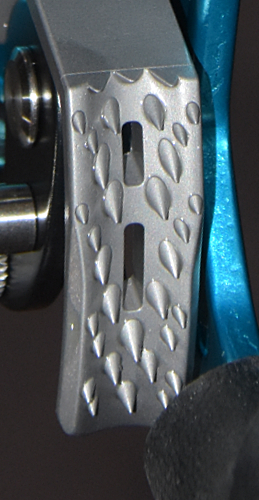 The cam is a reinforced stainless steel steel casting. The cam radius increases from 36 to 54 mm. over an angle of 36°, giving a 32° cam angle. The cam has
number of small conical teeth, all of which have their axes approximately
parallel to the upper surface of the cam. The cam face is divided by two short vertical slots designed to provide
clearance for mud. The tooth pattern is (3.4)((1S1)^2(4)(1S1)^4(5.4.3, where the "S"s stand for
a longitudinal mud removal slot. Like many other ascenders, the inner cam face radius
reduces from top to bottom to accommodate various sized ropes.
The cam is a reinforced stainless steel steel casting. The cam radius increases from 36 to 54 mm. over an angle of 36°, giving a 32° cam angle. The cam has
number of small conical teeth, all of which have their axes approximately
parallel to the upper surface of the cam. The cam face is divided by two short vertical slots designed to provide
clearance for mud. The tooth pattern is (3.4)((1S1)^2(4)(1S1)^4(5.4.3, where the "S"s stand for
a longitudinal mud removal slot. Like many other ascenders, the inner cam face radius
reduces from top to bottom to accommodate various sized ropes.
A spring-loaded manual safety
hook is attached to the side of the cam. The normal action of
the spring holds the safety against the cam. When the cam is opened,
the shell interferes with the safety hook, thus preventing opening
the cam. If the safety hook is moved away from the cam (opposing
the spring), it will clear the shell and the cam will open. At
full open the safety can be released and the spring will hold
the safety against the back of the shell. This provides a means
of locking the cam open. A knurled pin on the safety assists in operating
the safety mechanism. A second, shorter pin rides against the rope channel when the cam is nearly closed. This pin not only serves as a cam stop, but also assists in opening the cam by levering the cam open when the longer pin is pulled downward.
The front of the shell is stamped with with a logo, "XINDΛ,"and a hollow arrow with "UP" inside. The rear is printed with the UIAA logo, "CE 1019," "EN 567:2013," "Max 150KG," "ROPE:Ø8-13mm," a book-with-an-"i" icon, "MADE IN CHINA," and "183291472X0194."
These are well-made ascenders and
perform much like the Petzl Ascension.
All sharp edges have been removed. The attachment points are simple
yet well-rounded holes in the shell; even so, I would consider
their small radius too sharp for directly attaching sling ropes.
They are probably acceptably rounded for webbing, but considering
the proximity of the attachment points to the main rope, I would
recommend using a small maillon for most attachments in order
to reduce the risk of sling abrasion.
The upper rope attachment
hole is located very close to the main rope. A carabiner through
the upper attachment hole will probably drag on the main line.
Note that such a carabiner will prevent putting the ascender on
or off rope, so one’s climbing system must be designed accordingly.
Normally I don't like tab-type safeties, but ratherr than just being a bent piece of sheet metal, this one is sized and shaped quite nicely. The safety is easy to use with one hand.
The
ribbed handle is comfortable, even for my large hands, but of course I
don't climb by gripping ascenders by their handle.
While the frame and handle are essentially identical to the same parts of Version A, the cam and cam safety are different. The cam is very well made. The cam-mounted safety and incorporated cam stop works quite well.
This ascender has the same pit lip disadvantage as the Clog and other stamped frame ascenders,
although the reinforcing will help prevent bending. The reinforcing is similar to that found on various Climbing Technology ascenders and their equivalents, but the front strap and upper shell reinforcing are continuous on the Climbing Technology (etc. )ascenders and separated on the Xinda.
Overall, I think that this is a very nice handled ascender.
[ Top
| Version A
| Version B
| Return to H.E.C. Ascenders
]
Version C
(#3441)
Technical Details
I acquired my Xinda, Version C from Edgar Gutierrez in 2021.
Version C is 202 mm. tall, 94 mm. wide, 29 mm. thick, and weighs 243 g.
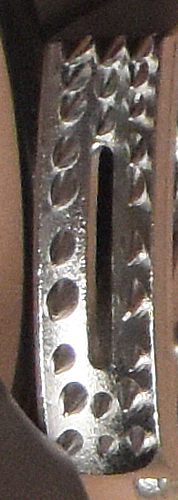 The shell is a tall irregular shaped stamping made from 3.9 mm. aluminum alloy sheet metal. A 15 mm. wide rope channel is formed in the upper portion of one side
and a smaller cam channel lies opposite the first. A hole drilled
through both sides of the cam channel accepts a semitubular rivet
which enters from the front and is expanded in the rear. The cam,
cam spring and a spacing washer are mounted on this rivet. The handle
below the cam has a hand grip molded
into place. The handle a "rubbery" feel. The hand grip has a small index finger support.
A 16.2 mm. sling attachment hole is punched below the handle
opening, and a second 11.2 mm. hole is punched beside it. A 13.7 by 19.7 mm. oval hole through both sides
of the rope channel provides an attachment point just above the
cam, and a 15.5 mm. hole beside it provides a second attachment
point.
The shell is a tall irregular shaped stamping made from 3.9 mm. aluminum alloy sheet metal. A 15 mm. wide rope channel is formed in the upper portion of one side
and a smaller cam channel lies opposite the first. A hole drilled
through both sides of the cam channel accepts a semitubular rivet
which enters from the front and is expanded in the rear. The cam,
cam spring and a spacing washer are mounted on this rivet. The handle
below the cam has a hand grip molded
into place. The handle a "rubbery" feel. The hand grip has a small index finger support.
A 16.2 mm. sling attachment hole is punched below the handle
opening, and a second 11.2 mm. hole is punched beside it. A 13.7 by 19.7 mm. oval hole through both sides
of the rope channel provides an attachment point just above the
cam, and a 15.5 mm. hole beside it provides a second attachment
point.
The cam is a stainless steel casting with
a semi-open web.
The cam radius increases from 38 to 57 mm. over an angle of 44°, giving a 28° cam angle. The cam has number of small conical teeth, all of which have their axes approximately aligned with the cam axle. The tooth pattern is
(3)^3(1S1)^5(3)^2.
A spring-loaded manual safety tab is mounted on the bottom of the cam with a steel semi-tubular rivet. The normal action of the spring holds the safety against the cam. When the cam is opened, the shell interferes with the safety bar, thus preventing opening the cam. If the safety bar is moved away from the cam (opposing the spring), it will clear the shell and the cam will open. At full open the safety can be released and the spring will hold the safety against the back of the shell. This provides a means of locking the cam open.
The front of the rope channel is printed with an up-pointing arrow, "UP," the Xinda logo, "XINDA," "CE 1019," "EN 567," "FOR ROPE:Ø8-12MM," and "17/06." The top of the handgrip is printed with the Xinda logo and "XINDA,"
The Xinda, Version C is a member of the largest group of similar stamped-frame handled eccentric-cam ascenders in my collection. From a broad perspective, the following ascenders are closely related, with a number of differences (sometimes functionally significant) as indicated:
|
|
| Image |
Ascender |
Frame
Shape |
Frame
Reinforce-
ment? |
Cam Stop |
Cam
Type |
Cam
Safety |
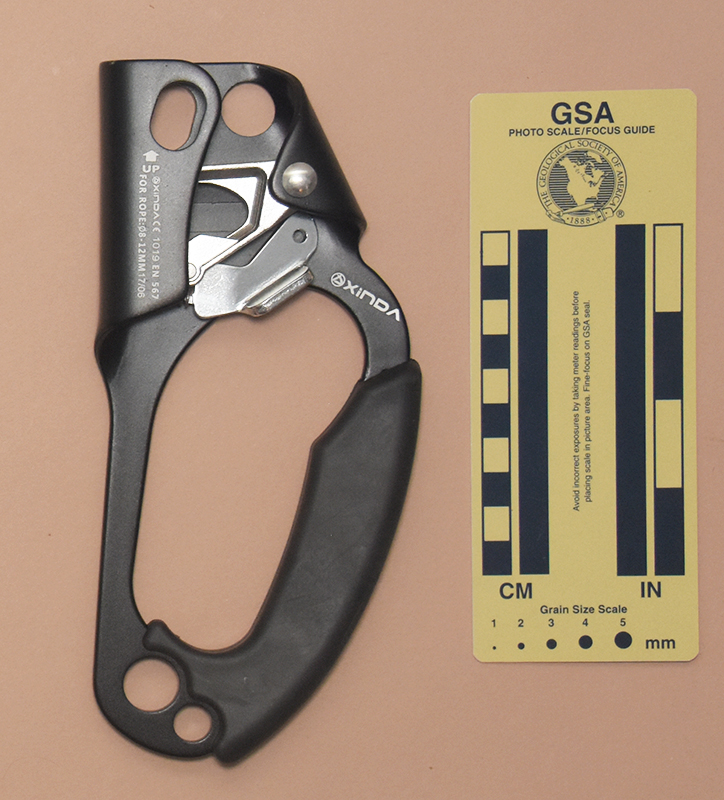 |
Xinda, Version C |
"Fixe" |
No |
No |
Semi-open
Web |
Aluminum
/w Tab |
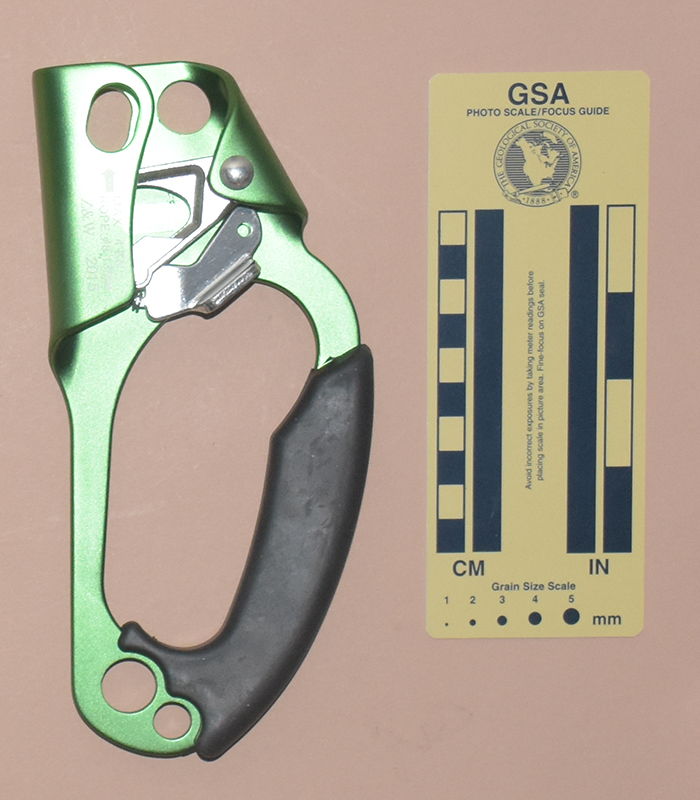 |
Z&W, Version B |
"Fixe" |
No |
No |
Semi-open
Web |
Aluminum
/w Tab |
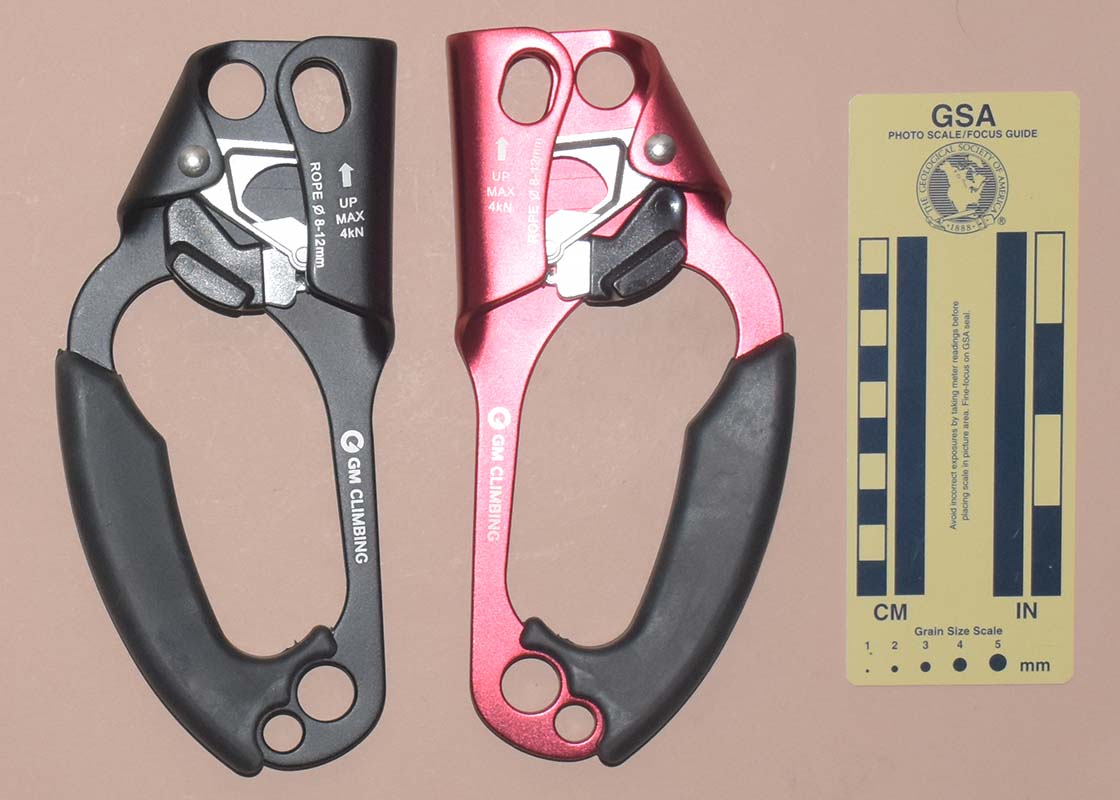 |
GM Climbing
Version B |
"Fixe" |
No |
No |
Semi-open
Web |
Plastic-
covered
Aluminum |
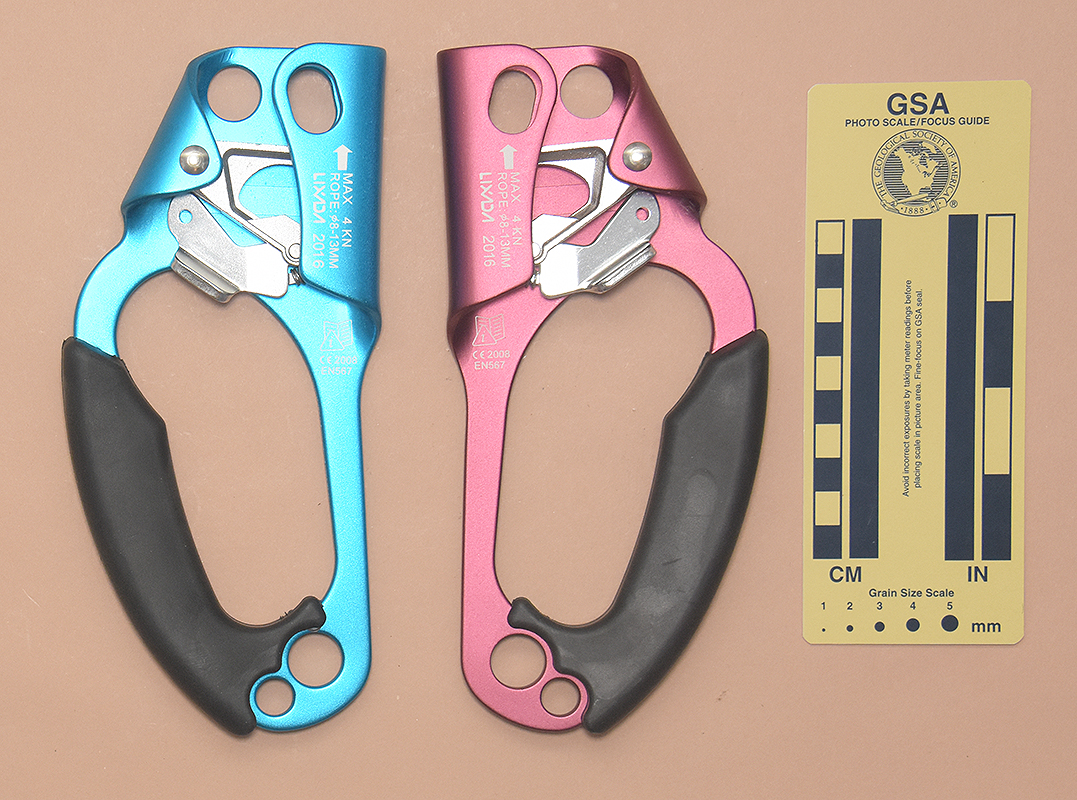 |
Lixada, Version B |
"Fixe" |
No |
No |
"Lixada"
Semi-open
Web |
Aluminum
/w Tab |
 |
Metolius |
"Fixe" |
No |
No |
Asymmetrical
Open-web |
Aluminum
/w Tab |
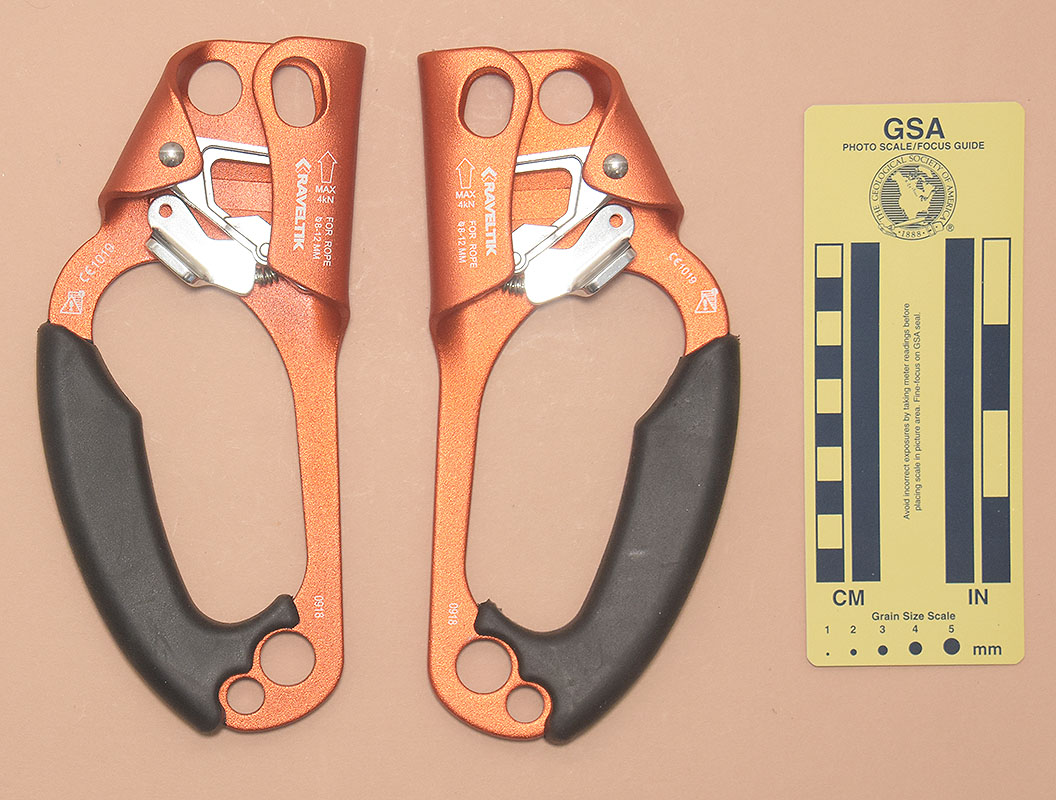 |
Raveltik Sherpa |
"Fixe" |
No |
No |
Asymmetrical
Open-web |
Aluminum
/w Tab |
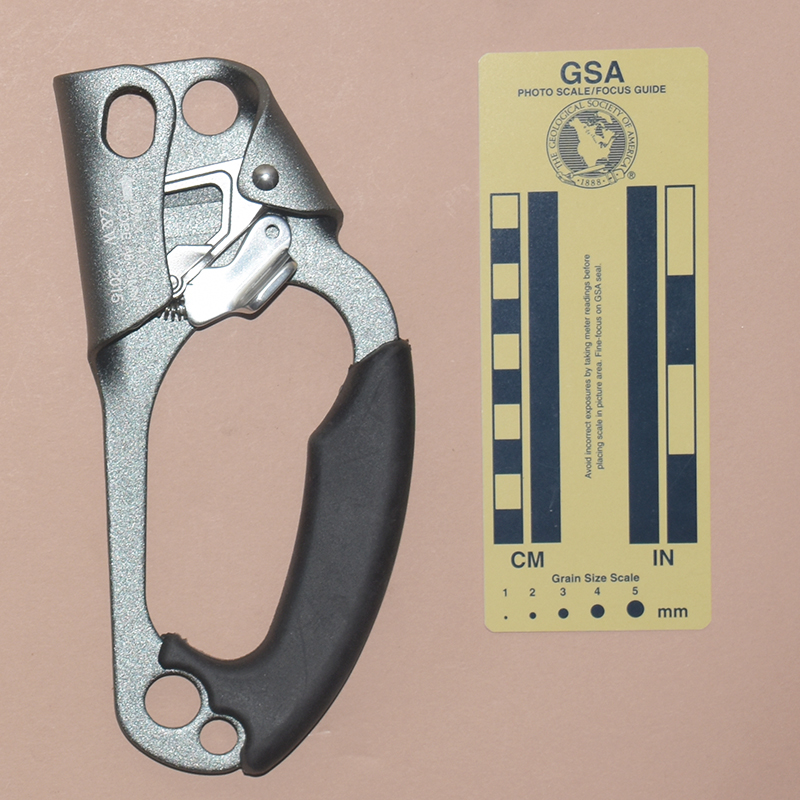 |
Z&W, Version A |
"Fixe" |
No |
No |
Asymmetrical
Open-web |
Aluminum
/w Tab |
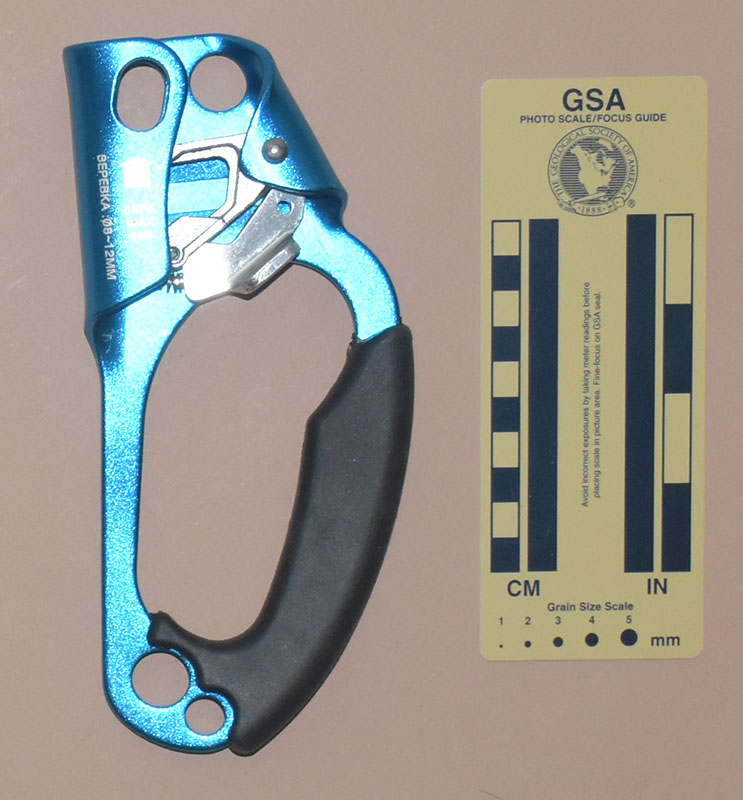 |
Венто (Vento) |
"Fixe" |
No |
No |
Left-handed
Asymmetrical
Open-web |
Aluminum
/w Tab |
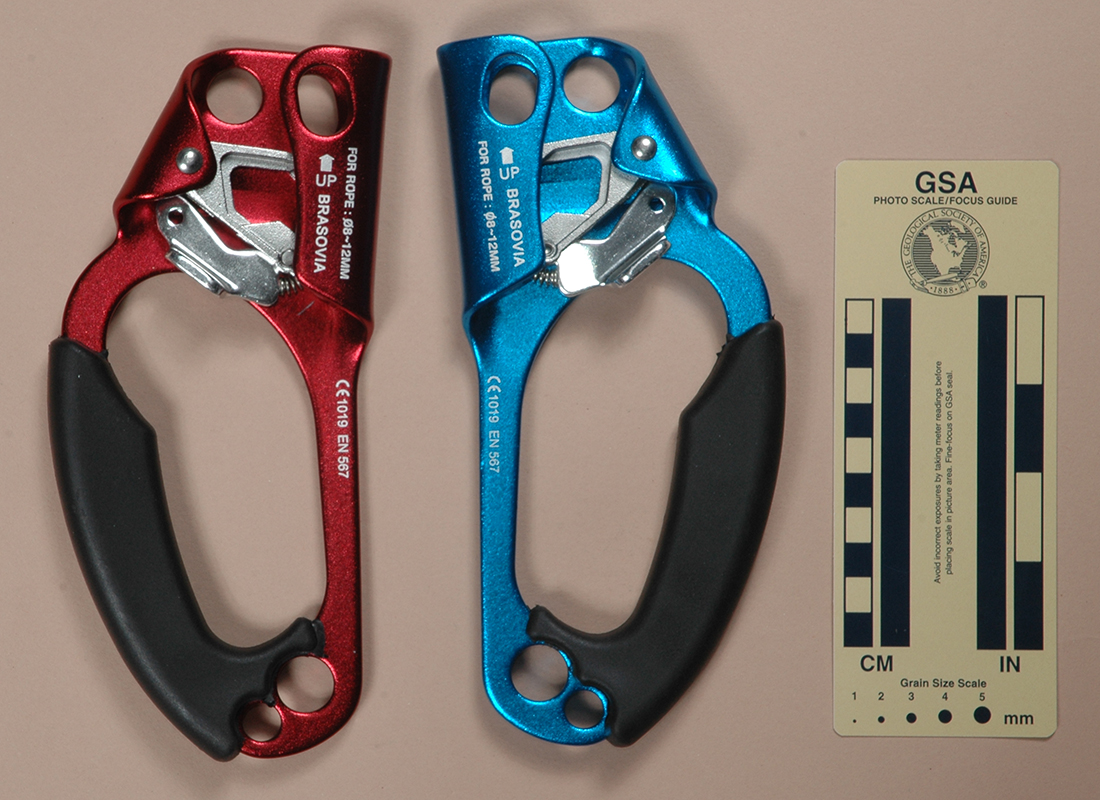 |
Brasovia |
"Fixe" |
No |
No |
Left-handed
Asymmetrical
Open-web |
Aluminum
/w Tab |
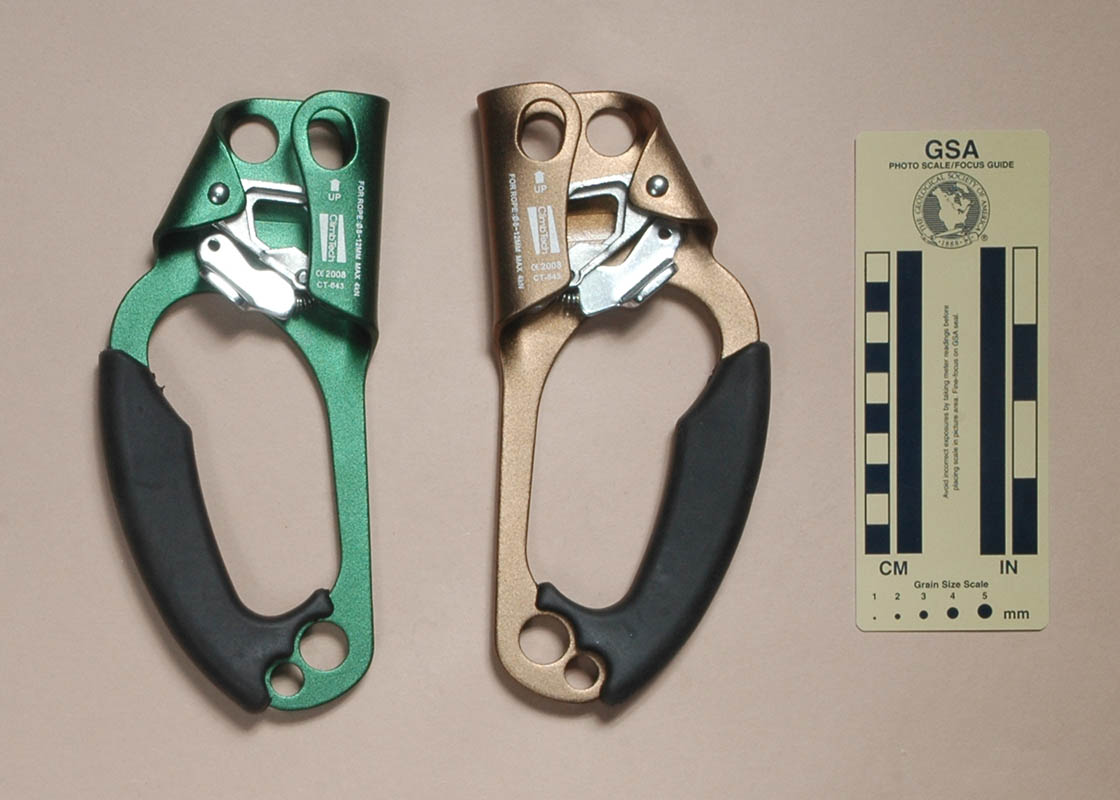 |
Climb Tech |
"Fixe" |
No |
No |
Left-handed
Asymmetrical
Open-web |
Aluminum
/w Tab |
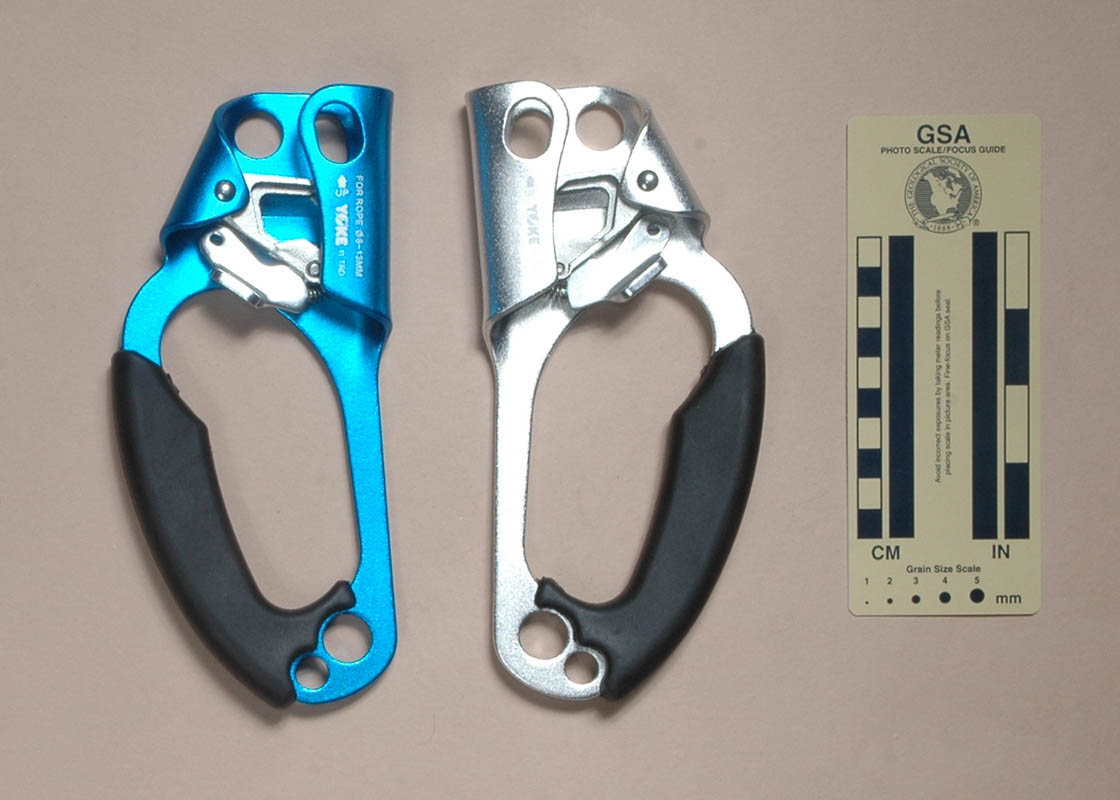 |
Yoke |
"Fixe" |
No |
No |
Left-handed
Asymmetrical
Open-web |
Aluminum
/w Tab |
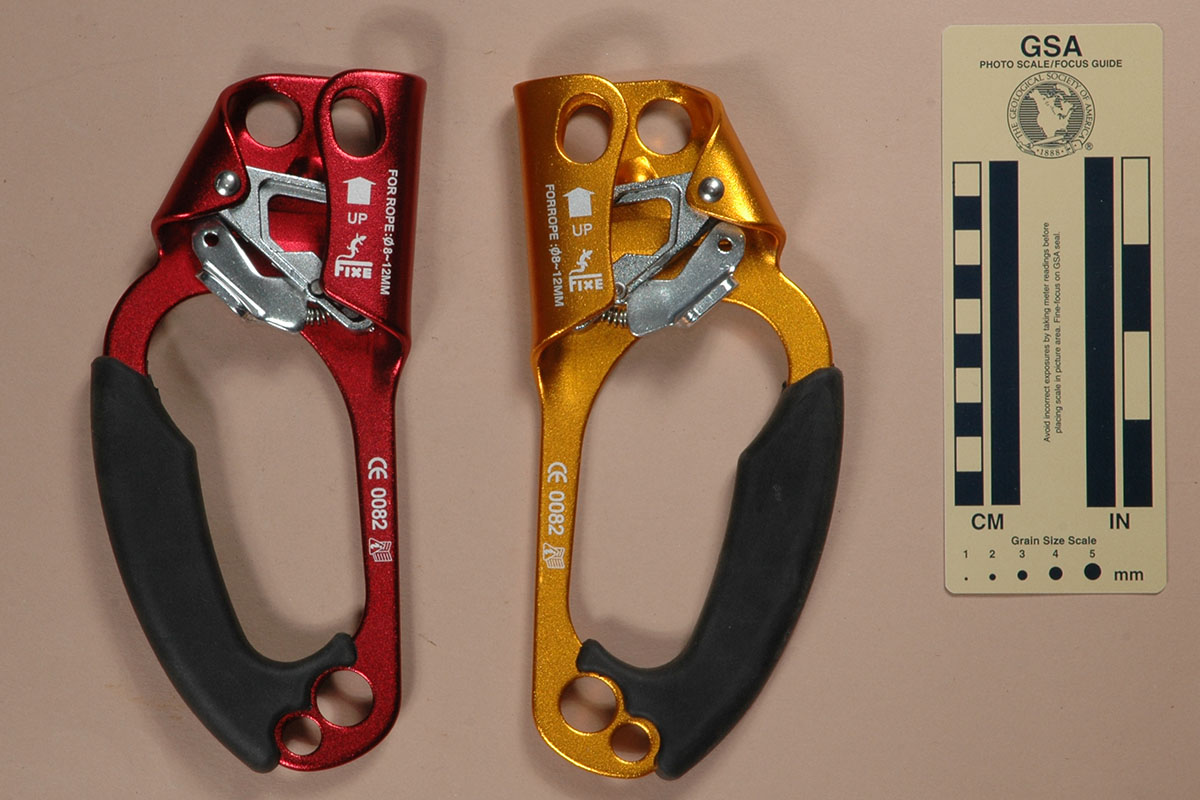 |
Fixe Capitan |
"Fixe" |
No |
Yes |
Left-handed
Asymmetrical
Open-web |
Aluminum
/w Tab |
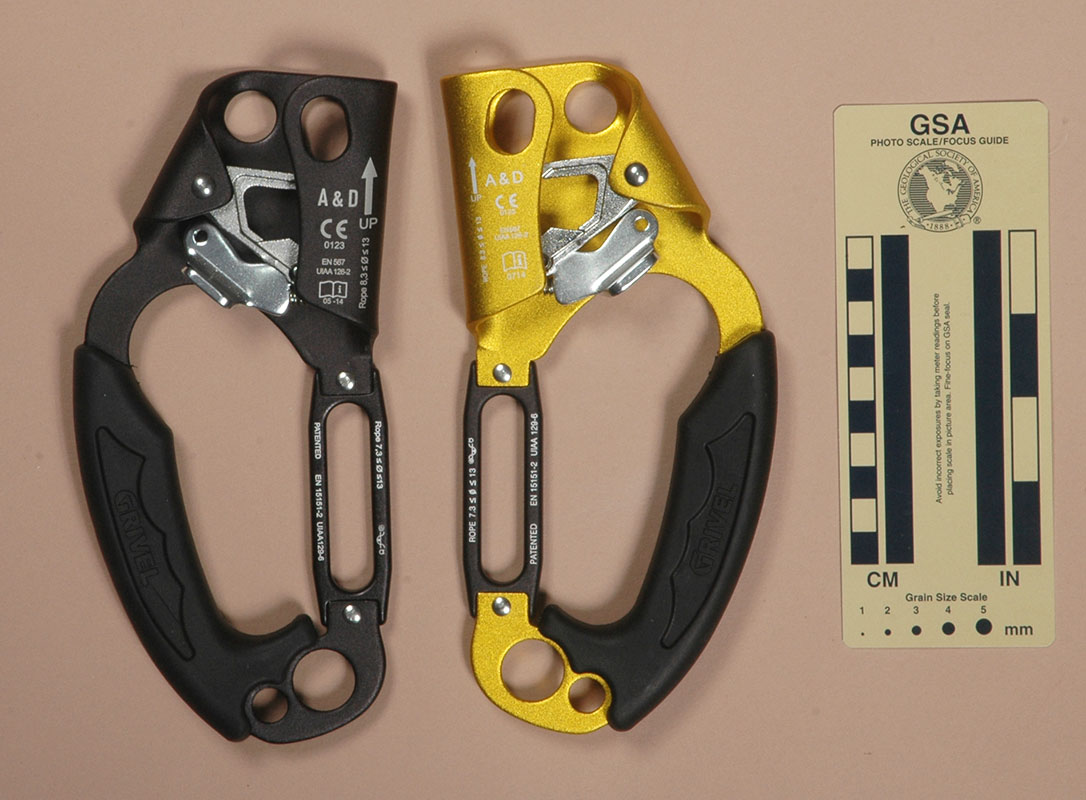 |
Grivel A&D,
Version A |
"Grivel
A&D" |
No |
No |
Left-handed
Asymmetrical
Open-web |
Aluminum
/w Tab |
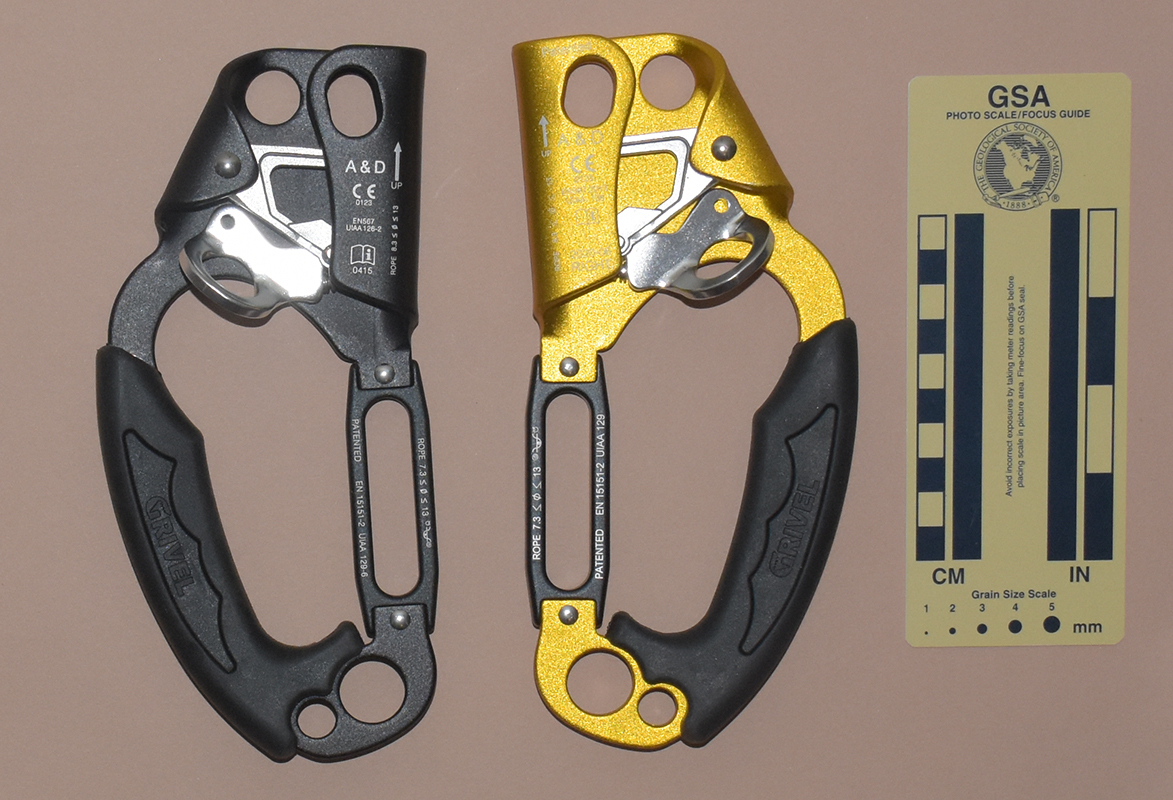 |
Grivel A&D,
Version B |
"Grivel
A&D" |
No |
No |
Asymmetrical
Open-web |
Aluminum
/w Ring |
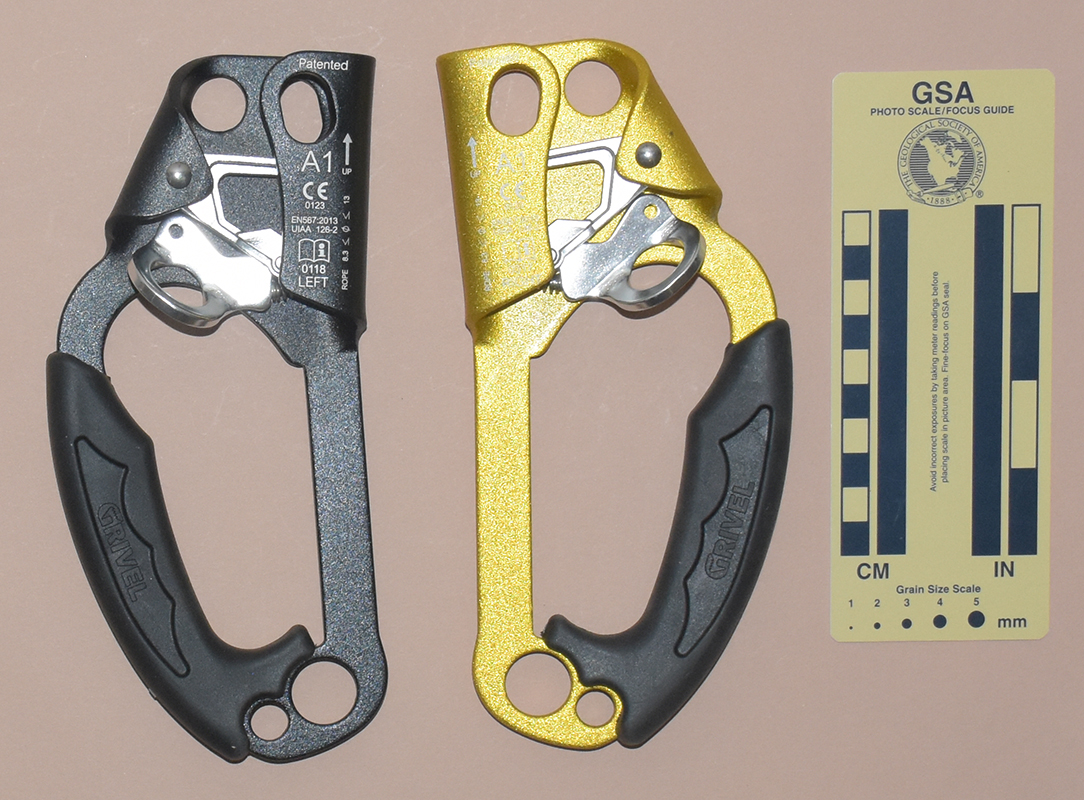 |
Grivel
A1 |
"Grivel
A1" |
No |
No |
Asymmetrical
Open-web |
Aluminum
/w Ring |
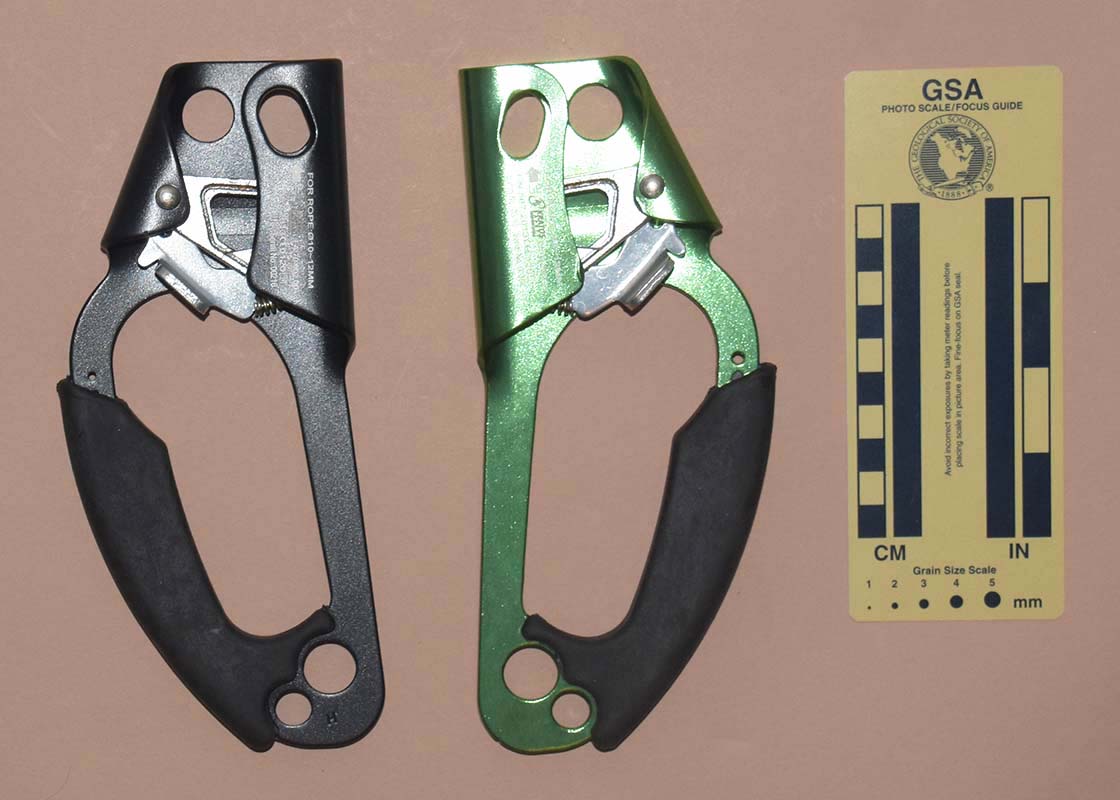 |
Kratos |
"Kratos" |
No |
No |
"Kratos"
Asymmetrical
Open-web |
Aluminum
/w Kratos Tab |
|
These are all well-made ascenders that perform much like the
Petzl Ascension. All sharp edges have been
removed. The attachment points are simple holes
in the shell. In some cases, the user may wish to round the lower attachment holes with a Swiss file; even so, I would consider their small radius too
sharp for directly attaching sling ropes. They are probably acceptably
rounded for webbing (or could be made so with a file), but considering the proximity of the attachment
points to the main rope, I would recommend using a small maillon
for most attachments in order to reduce the risk of sling abrasion.
The lower attachment hole could theoretically have the same safety
problems as the one on Clog Version A.
I'm not sure the extra holes are needed at the base. Except for the Petzl Pompe, I've never found a real need for a second hole. Some people like them, and I might find them more appealing if they were large enough for a standard carabiner to fit through.
The doubled upper rope attachment hole is located very close to the main
rope. A carabiner through the upper oval attachment hole will
probably drag on the main line. The main purpose for this hole is when using the ascender as a safety on a fixed line. The axis of the oval hole is canted so that when trailing the ascender upward, the ascender pulls free of the rope, but it drags a bit if the used falls. I consider this practice dangerous and cannot recommend it. The single upper rope attachment hole, when used in conjunction with the frame side of the double hole, facilitates using the ascender as a chest ascender as shown in the Fixe Capitan instructions.
These ascenders have the same pit lip disadvantage as the Clog and other stamped frame ascenders,
and there is no stamped reinforcing to help prevent bending.
Each has a rubber handle that is comfortable enough for my large hands,
but I don't climb by gripping ascenders at their handle. I think
it is better to simply grasp the ascender from above and lift
the ascender in the traditional manner (unless, of course, you are one of those people who climbs Frog).
With the exception of those on the Kratos, the cams on these ascenders are very well made. Some have open-web cams and others are semi-open. The latter appears to be the later design. I don't think the difference is important. The area behind the cam face is sloped on some of these ("asymmetrical") and not sloped ("symmetrical") on others. Again, I don't think the difference is significant.
The asymmetrical cams have a (3)^3(2)(1S1)^4(3)^2 tooth pattern while the slot in the symmetrical cams is slightly longer (extending to between the top tooth pair), giving a (3)^3(1S1)^5(3)^2 tooth pattern. The Lixada, Version B and Kratos have their own tooth patterns. I don't find that these tooth pattern differences affect cam performance. Some of the models have two identical left-handed cams and some have separate left- and right-handed cams. I do not see any performance difference.
I've heard that the teeth some of these cams wear quickly. I haven't put enough miles on any of these to make a proper comparison, but I would expect the chrome-plated cams on some other brands to last longer than unplated steel cams.
The price for any of these ascenders was much lower than that of American or European ascenders. Some have softer cams that wear faster than American or European equivalents, but lower prices frequently offset the reduced longevity. One potential concern is that we don't have the experience with Chinese metallurgy and quality control that we have with American and European devices. Americans, Europeans, and Chinese all make some high-quality products and some low-quality products. I think that these ascenders are fine and most of them have legitimate CE markings. If I wanted to use a stamped-frame ascender, I would not hesitate to use any of these, but I would like more information and experience with Chinese ascenders before I'm willing to make a final judgement.
[ Top
| Version A
| Version B
| Version C
]


